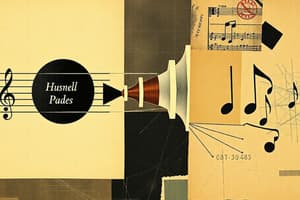Podcast
Questions and Answers
Which of the following best describes the primary function of music genres?
Which of the following best describes the primary function of music genres?
- To define music based solely on its historical significance.
- To categorize instruments based on their construction.
- To offer different ways to experience music through shared characteristics. (correct)
- To standardize the techniques used in music composition.
What role does music primarily play in cultural contexts?
What role does music primarily play in cultural contexts?
- It solely communicates entertainment value and popularity.
- It serves only as entertainment without cultural implications.
- It transmits cultural stories and reflects societal beliefs and traditions. (correct)
- It functions primarily as a commercial tool for artists.
Which element is key to understanding the differences in musical styles?
Which element is key to understanding the differences in musical styles?
- The commercial success of the musical piece.
- The historical period in which the music was created.
- The popularity of the genre among listeners.
- The specific instrumentation and techniques used in the music. (correct)
How do subgenres relate to main musical genres?
How do subgenres relate to main musical genres?
Which statement is true regarding the impact of musical instruments on music?
Which statement is true regarding the impact of musical instruments on music?
What defines the musical identity of a piece?
What defines the musical identity of a piece?
Which element of music is primarily concerned with the combination of notes played simultaneously?
Which element of music is primarily concerned with the combination of notes played simultaneously?
Which term describes the speed of music, usually measured in beats per minute?
Which term describes the speed of music, usually measured in beats per minute?
What is the primary purpose of musical notation throughout history?
What is the primary purpose of musical notation throughout history?
Which element of music relates to the unique quality of a sound distinguishing one instrument from another?
Which element of music relates to the unique quality of a sound distinguishing one instrument from another?
How does music typically affect the human brain?
How does music typically affect the human brain?
What is an example of a common musical form?
What is an example of a common musical form?
What role did early musical instruments primarily serve in societies?
What role did early musical instruments primarily serve in societies?
Flashcards
Genres
Genres
Categories of music based on shared characteristics like instruments and structure.
Subgenres
Subgenres
Smaller categories within a main music genre that share specific characteristics.
Timbre
Timbre
The quality or color of sound produced by a musical instrument.
Cultural Expression in Music
Cultural Expression in Music
Signup and view all the flashcards
Role of Music in Society
Role of Music in Society
Signup and view all the flashcards
Music
Music
Signup and view all the flashcards
Melody
Melody
Signup and view all the flashcards
Harmony
Harmony
Signup and view all the flashcards
Rhythm
Rhythm
Signup and view all the flashcards
Tempo
Tempo
Signup and view all the flashcards
Dynamics
Dynamics
Signup and view all the flashcards
Form
Form
Signup and view all the flashcards
Study Notes
Characteristics of Music
- Music is an art form that uses sound to express ideas, emotions, or tell stories.
- It often involves organized patterns of pitch (melody), rhythm, harmony, and timbre (tone color).
- Music can evoke a wide range of emotions in listeners and can serve various purposes, from entertainment to spiritual expression.
- Musical elements such as melody, harmony, rhythm, form, and timbre create a compositional structure.
- The organization of these elements defines a piece of music's musical identity.
- Different cultures have unique musical traditions, styles, and instruments.
Elements of Music
- Melody: A sequence of musical notes perceived as a single, coherent line. It can be simple or complex, and move in various directions.
- Harmony: The combination of different musical notes or chords played simultaneously to create a sense of richness.
- Rhythm: The organization of sounds in time, describing the duration and emphasis of notes.
- Tempo: The pace or speed of the music, usually measured in beats per minute.
- Dynamics: The degree of loudness or softness in music, often denoted by Italian terms like "piano" (soft) and "forte" (loud).
- Timbre (Tone Color): The unique quality of a sound that distinguishes one instrument or voice from another; it's the sound's "color."
- Form: The overall structure or organization of a piece of music, including sections, phrases, and repetitions. Common forms include sonata form, theme and variations, and ternary form (ABA).
Music and the Brain
- Music engages multiple areas of the brain, including those associated with memory, emotion, and language.
- Scientifically linked to positive emotions and emotional responses.
- Music enhances mood and creates a feeling of well-being in some individuals.
- Musical training potentially improves cognitive development, memory, and focus.
History of Music
- Music has existed in various forms throughout human history and across cultures.
- Early musical instruments likely developed for ceremonial and social functions.
- Musical notation allowed the preservation and transmission of music across generations.
- Western music evolved over centuries, influenced by different periods and styles.
- Various musical genres and traditions developed within societies reflecting cultural values, history, and social structures.
Musical Genres and Styles
- Genres categorize music based on shared characteristics like instruments, structure, and cultural context, offering diverse listening experiences.
- Examples include Classical, jazz, rock, pop, country, and many more, with subgenres within each.
- Various styles developed within existing genres over time.
- Unique characteristics or techniques distinguish different styles.
Musical Instruments
- Musical instruments range from simple wind instruments to complex stringed and percussion instruments.
- Instruments vary in construction and sound production.
- The chosen instrument affects the music's timbre or tone color.
Music and Culture
- Music is vital in cultural expression and identity.
- It reflects the values, beliefs, and traditions of a society or group.
- Music can transmit cultural stories and mark significant life events.
- Diverse cultures employ music in ceremonies, rituals, celebrations, and everyday life.
Studying That Suits You
Use AI to generate personalized quizzes and flashcards to suit your learning preferences.





